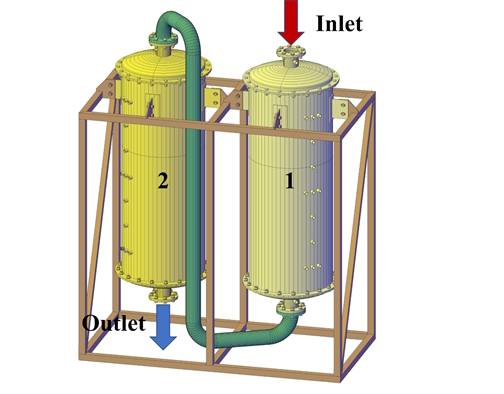Completed: SANDTHERM: Deployment of a novel medium-high temperature waste heat recovery unit based on foundry sands
In collaboration with Kelvin Thermotech, Mantec Technical Ceramics and the Boro Foundry
SANDTHERM demonstrated the technical and economic feasibility of using waste foundry sand (WFS) as a thermal energy storage (TES) material for medium-high temperature waste heat recovery applications. It deployed, operated and monitored a waste heat storage and reuse unit using TES materials containing WFS. This novel material was composed of 40% phase change material (PCM), 20% WFS and 20% MgO. Two PCM’s were selected to improve system efficiency by maximizing latent heat. These were NaNO3 and a 60-40 NaNO3-KNO3 mixture with melting points of 309℃ and 218℃, respectively. The materials had a density of 1.65 and 1.93 g/cm3, average specific heat capacity 1.23 J/gK and 1.22 J/gK and average thermal conductivity, 1.63 W/mK and 1.48 W/mK for NaNO3 and 60-40 NaNO3-KNO3, respectively. The device was charged using a high temperature fan with an average mass flowrate of 0.028 kg/s and an inlet temperature of 400 ℃, which was the maximum capacity of the 10 kW heater. Total charging time was 10h followed by a total discharging time for 24h. System efficiency was 76.1%. A robust, computationally inexpensive CFD model was able to predict system efficiency and using UK pricing the payback time was approx. 15 years. Improvements in efficiency to 90% coupled with more competitive global material and manufacturing pricing suggest the potential to achieve a payback period of approx. 5.6 years. The PI has obtained follow-up funding under Marie Skłodowska-Curie Actions (101068507) to extend this process to other foundation industry waste materials. He has disseminated the data to several leading companies and will present the findings at the 17th International Heat Transfer Conference as well as the Eurotherm Seminar: Innovative solutions for thermal energy storage deployment and within relevant peer-reviewed publications (Journal of Energy Storage).

Publications
A comprehensive material and experimental investigation of a packed bed latent heat storage system based on waste foundry sand, https://doi.org/10.1016/j.energy.2024.130920

Dr Argyrios Anagnostopoulos
University of Birmingham
Dr. Argyrios Anagnostopoulos is currently a Research Fellow at the University of Birmingham, specializing in Thermal Energy Storage (TES) systems with particular emphasis in medium-high temperature latent heat storage using molten salts. He has a bottom to top knowledge of the field ranging from material characterization to system modelling. He is the corresponding author of 9 and co-author of 5 peer-reviewed papers in highly rated journals in the field of energy and waste valorisation., as well as co-author of an RSC Book chapter on TES material modelling. He obtained his PhD in 2020 (University of Birmingham, Chemical Engineering) after graduating from the University of Surrey (MSc in Renewable Energy Systems Engineering).
Published: February 11th, 2022
Posted in
projects





